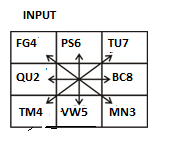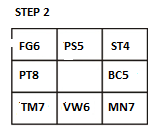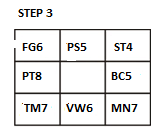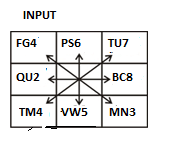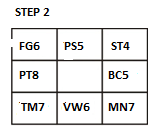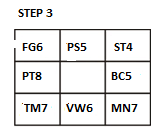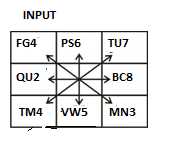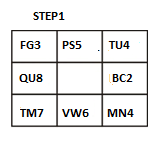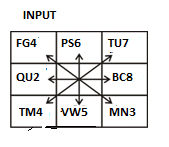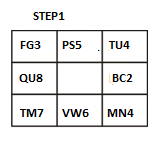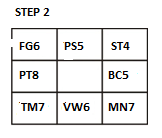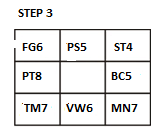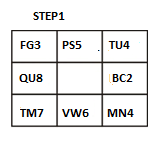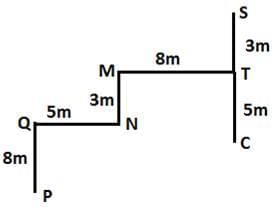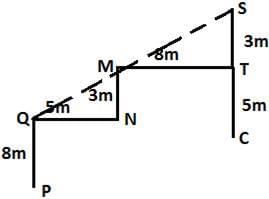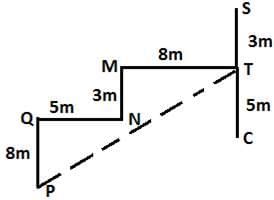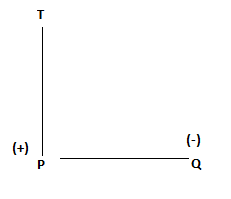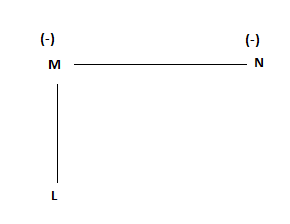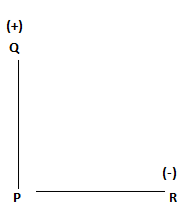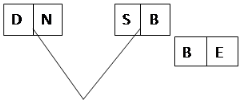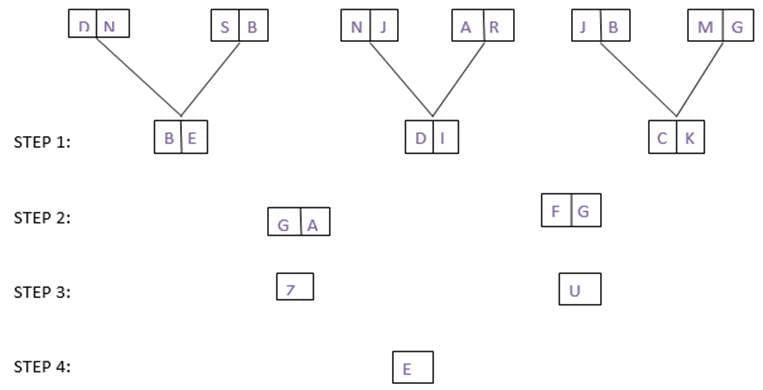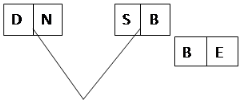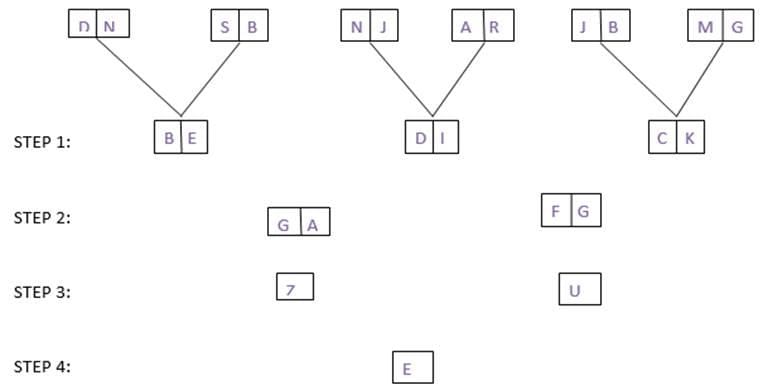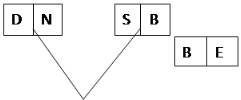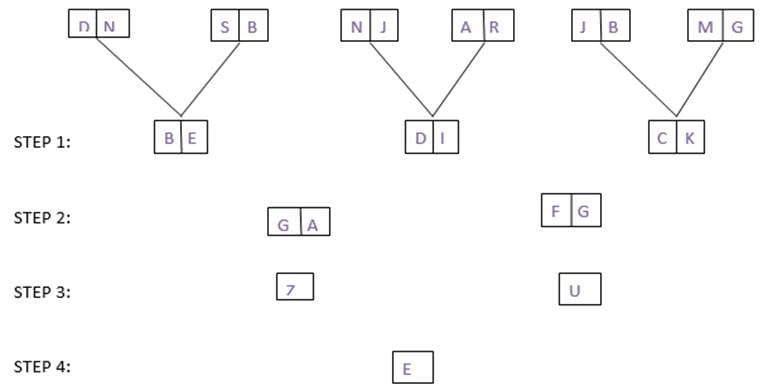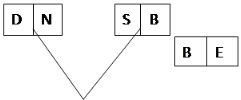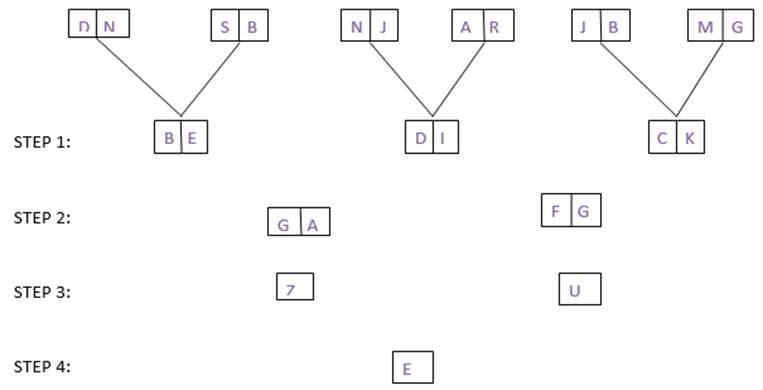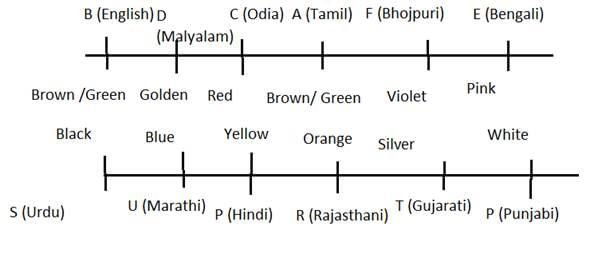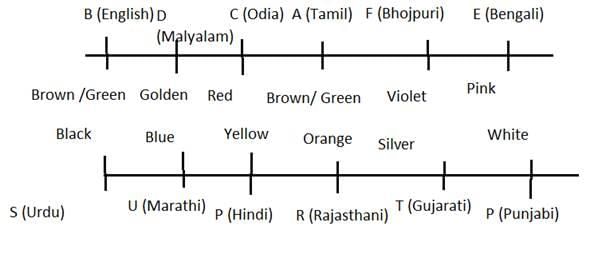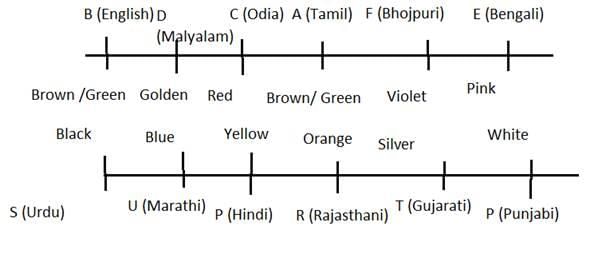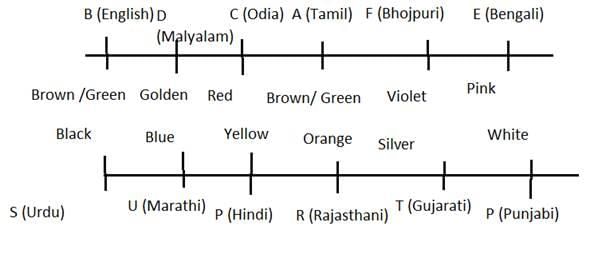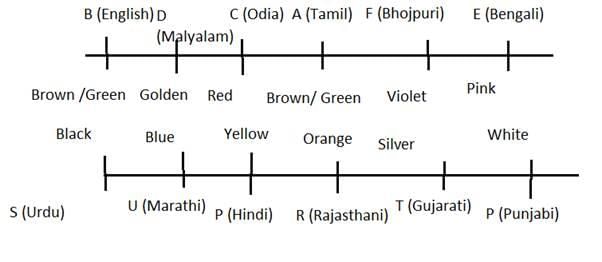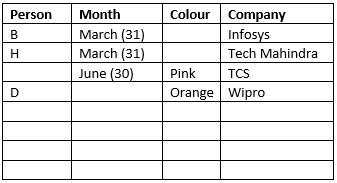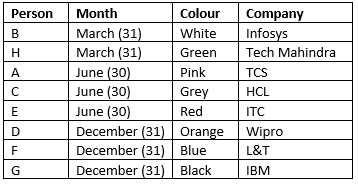IBPS Clerk Mains Mock Test - 5 - Bank Exams MCQ
30 Questions MCQ Test - IBPS Clerk Mains Mock Test - 5
Direction: Study the given information carefully and answer the given questions.
Study the following diagram and convert it into other diagrams.
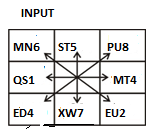
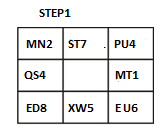
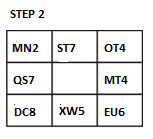
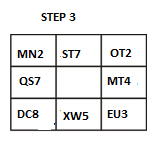
As per the rules followed in the above step, find out the appropriate steps for the given input.
And answer the following questions:
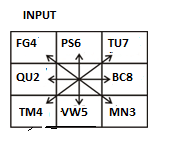
Q. Which number comes in step-2 in the third column of second row?





Direction: Study the given information carefully and answer the given questions.
Study the following diagram and convert it into other diagrams.
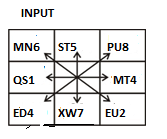
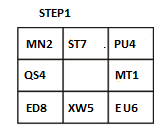
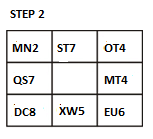
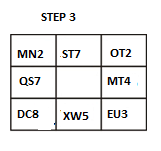
As per the rules followed in the above step, find out the appropriate steps for the given input.
And answer the following questions:
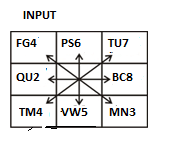
Q. Which element replaces ‘MN7’ in step-3?





Direction: Study the given information carefully and answer the given questions.
Study the following diagram and convert it into other diagrams.
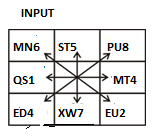
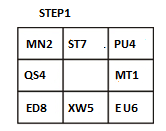
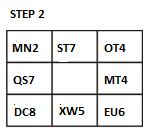
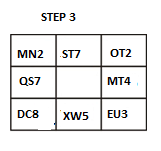
As per the rules followed in the above step, find out the appropriate steps for the given input.
And answer the following questions:

Q. What is the sum the number 3rd row of 2nd column in step 2 and 3rd column of 2nd row in step2?





Direction: Study the given information carefully and answer the given questions.
Study the following diagram and convert it into other diagrams.
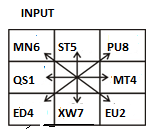
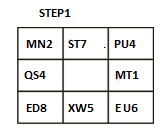
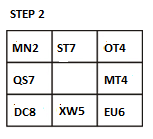
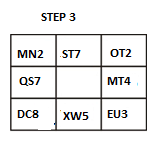
As per the rules followed in the above step, find out the appropriate steps for the given input.
And answer the following questions:
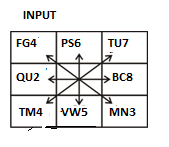
Q. Which element replaces ‘QU8’ in step-2?
Direction: Study the given information carefully and answer the given questions.
Study the following diagram and convert it into other diagrams.
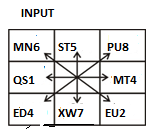
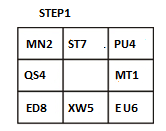
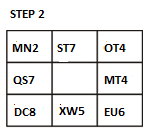
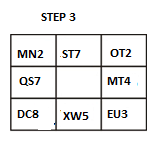
As per the rules followed in the above step, find out the appropriate steps for the given input.
And answer the following questions:
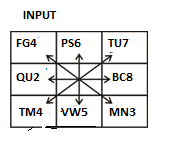
Q. Which elements comes in step-3 in the third column of second row?
Direction: Read the following information carefully to answer the questions that follow. The questions are based on following coding formats:
& = North, @ = West, % = South, # = East, $ = 3m, ! = 8m, ^ = 5m
Example
A & B means A is north of B
A @ B means A is west of B
A % B means A is south of B
A # B means A is east of B
A # $ B means A is 3m east of B
A % ! B means A is 8m south of B
Condition given are as:
M&$N
S&!C
P%!Q
C%^T
Q @ ^N
T#!M
Q. What is shortest distance between point T and point S?
Direction: Read the following information carefully to answer the questions that follow. The questions are based on following coding formats:
& = North, @ = West, % = South, # = East, $ = 3m, ! = 8m, ^ = 5m
Example
A & B means A is north of B
A @ B means A is west of B
A % B means A is south of B
A # B means A is east of B
A # $ B means A is 3m east of B
A % ! B means A is 8m south of B
Condition given are as:
M&$N
S&!C
P%!Q
C%^T
Q @ ^N
T#!M
Q. In which direction is point Q with respect to point S?
Direction: Read the following information carefully to answer the questions that follow. The questions are based on following coding formats:
& = North, @ = West, % = South, # = East, $ = 3m, ! = 8m, ^ = 5m
Example
A & B means A is north of B
A @ B means A is west of B
A % B means A is south of B
A # B means A is east of B
A # $ B means A is 3m east of B
A % ! B means A is 8m south of B
Condition given are as:
M&$N
S&!C
P%!Q
C%^T
Q @ ^N
T#!M
Q. What is shortest distance between Point P and Point T?
Direction: Study the information given below and answer the questions based on it.
# means either hour hand or minute hand is at 9
$ means either hour hand or minute hand is at 2
@ means either hour hand or minute hand is at 3
& means either hour hand or minute hand is at 5
% mean either hour hand or minute hand is at 12
+ means either hour hand or minute hand is at 8
Note: If two symbols are given then by default first symbol is considered as hour hand and second one is considered as minute hand . And all time are considered at AM.
For eg. #@ ⟶9:15 am
Q. A train takes 2 hours to go from Station A to Station B. It the train starts at @+ from Station A then at what time will it reach Station B?
Direction: Study the information given below and answer the questions based on it.
# means either hour hand or minute hand is at 9
$ means either hour hand or minute hand is at 2
@ means either hour hand or minute hand is at 3
& means either hour hand or minute hand is at 5
% mean either hour hand or minute hand is at 12
+ means either hour hand or minute hand is at 8
Note: If two symbols are given then by default first symbol is considered as hour hand and second one is considered as minute hand . And all time are considered at AM.
For eg. #@ ⟶9:15 am
Q. Rohit starts from home for school at ‘+$’. It takes him 30 minute to reach his school. At what time he reaches his school?
Direction: Study the information given below and answer the questions based on it.
# means either hour hand or minute hand is at 9
$ means either hour hand or minute hand is at 2
@ means either hour hand or minute hand is at 3
& means either hour hand or minute hand is at 5
% mean either hour hand or minute hand is at 12
+ means either hour hand or minute hand is at 8
Note: If two symbols are given then by default first symbol is considered as hour hand and second one is considered as minute hand . And all time are considered at AM.
For eg. #@ ⟶9:15 am
Q. Rahul has to catch a train that is scheduled to depart at ‘@#’. It takes him 3 hour and 20 minutes to reach the railway station from his homE. At what time should he leave from his home for the railway station to arrive at the station at least 25 minutes before the departure of the train?
Direction: Study the information given below and answer the questions based on it.
# means either hour hand or minute hand is at 9
$ means either hour hand or minute hand is at 2
@ means either hour hand or minute hand is at 3
& means either hour hand or minute hand is at 5
% mean either hour hand or minute hand is at 12
+ means either hour hand or minute hand is at 8
Note: If two symbols are given then by default first symbol is considered as hour hand and second one is considered as minute hand . And all time are considered at AM.
For eg. #@ ⟶9:15 am
Q. Train is scheduled to start at ‘$ @’. A passenger reaches the station 25 minutes after the departure of the train. At what time does the passenger reach the station?
Direction: Study the information given below and answer the questions based on it.
# means either hour hand or minute hand is at 9
$ means either hour hand or minute hand is at 2
@ means either hour hand or minute hand is at 3
& means either hour hand or minute hand is at 5
% mean either hour hand or minute hand is at 12
+ means either hour hand or minute hand is at 8
Note: If two symbols are given then by default first symbol is considered as hour hand and second one is considered as minute hand . And all time are considered at AM.
For eg. #@ ⟶9:15 am
Q. A bus is scheduled to start at ‘#$’ from the bus stand. If Anil reaches the bus stand 25 minutes before the schedule time, then at what time Anil reaches the bus stand?
Direction: Study the following information carefully to answer the given questions:
If 'A () B' means 'B is the mother of A'
If 'A of B' means 'B is the father of A'
If 'A ÷ B' means 'B is the sister of A'
If 'A × B' means 'B is the brother of A'
If 'A + B' means 'B is the daughter of A'
If 'A − B' means 'B is the son of A'
Q. If ‘T – P ÷ Q’ is given, then how is Q related to T?
Direction: Study the following information carefully to answer the given questions:
If 'A () B' means 'B is the mother of A'
If 'A of B' means 'B is the father of A'
If 'A ÷ B' means 'B is the sister of A'
If 'A × B' means 'B is the brother of A'
If 'A + B' means 'B is the daughter of A'
If 'A − B' means 'B is the son of A'
Q. What does ‘L () M + N’ means?
Direction: Study the following information carefully to answer the given questions:
If 'A () B' means 'B is the mother of A'
If 'A of B' means 'B is the father of A'
If 'A ÷ B' means 'B is the sister of A'
If 'A × B' means 'B is the brother of A'
If 'A + B' means 'B is the daughter of A'
If 'A − B' means 'B is the son of A'
Q. If ‘P of Q + R’ is given, then which of the following is true?
Direction: Study the following information to the given questions- (High Level)
An input–output is given in different steps. Some mathematical operations are done in each step.
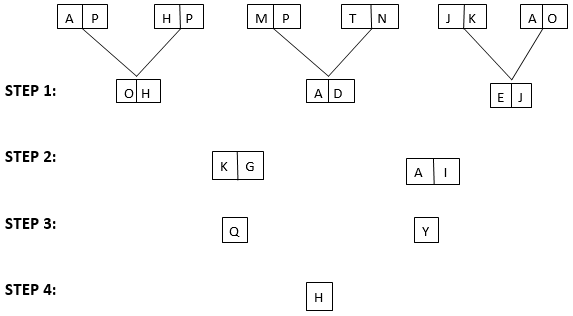
As per the rules followed in the steps given above, find out in each of the following questions the appropriate step for the given input.
![]()
Q. Which among the following is the place value of number obtained in the last step?
Direction: Study the following information to the given questions- (High Level)
An input–output is given in different steps. Some mathematical operations are done in each step.
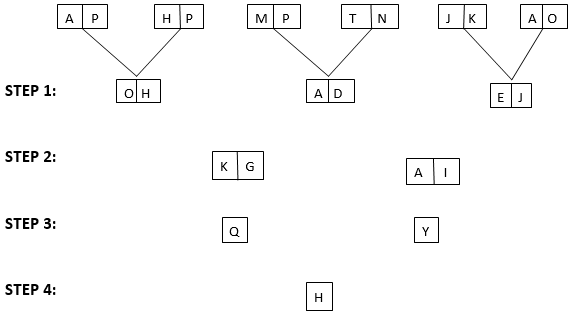
As per the rules followed in the steps given above, find out in each of the following questions the appropriate step for the given input.
![]()
Q. Which of the following is the alphabet obtained in the penultimate step?
Direction: Study the following information to the given questions- (High Level)
An input–output is given in different steps. Some mathematical operations are done in each step.
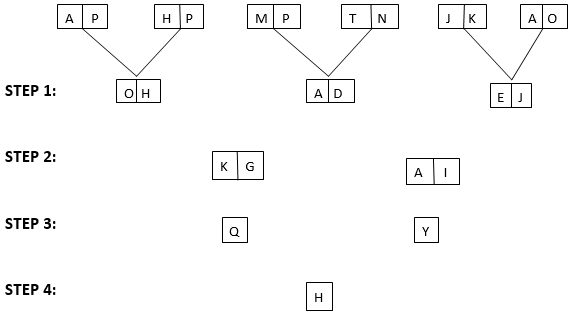
As per the rules followed in the steps given above, find out in each of the following questions the appropriate step for the given input.
![]()
Q. Find the number which can be obtained on adding the place value of alphabets obtained in last but one step?
Direction: Study the following information to the given questions- (High Level)
An input–output is given in different steps. Some mathematical operations are done in each step.
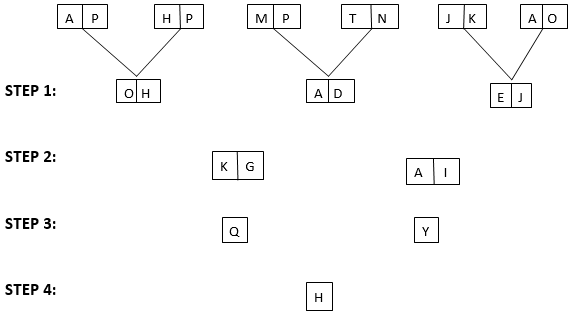
As per the rules followed in the steps given above, find out in each of the following questions the appropriate step for the given input.
![]()
Q. What is the number obtained on subtracting the place value of alphabet obtained in last step from 35?
Direction: Study the following information to the given questions- (High Level)
An input–output is given in different steps. Some mathematical operations are done in each step.
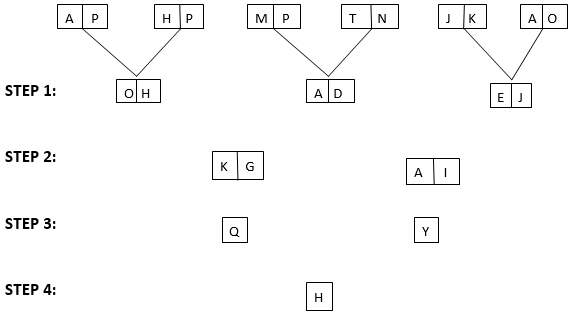
As per the rules followed in the steps given above, find out in each of the following questions the appropriate step for the given input.
![]()
Q. Which among the following alphabet obtained in first step?
Direction: In each of the following questions, assuming the given statements to be true, find out which of the following conclusions given below is/are definitely true.
Q. Statements:
W > H = I > C = L < E
Conclusions:
I. W > L
II. E > H
Direction: In each of the following questions, assuming the given statements to be true, find out which of the following conclusions given below is/are definitely true.
Q. Statements: @ ≥ %, $ ≤ %, # = @, $ = !, ! > &
Conclusion: a] % ≥ ! b] & < %
Direction: In each of the following questions, assuming the given statements to be true, find out which of the following conclusions given below is/are definitely true.
Q. Statements: F ≤ T, T > N, N ≤ F, B ≠ F, F = S
Conclusion:
I. B > F
II. F > B
Direction: Study the following information carefully to answer the questions.
Twelve persons from different states’ speak different languages viz. Hindi, English, Urdu, Bengali, Malyalam, Tamil, Gujarati, Marathi, Bhojpuri, Punjabi, Rajasthani and Odia are sitting in two parallel rows containing six people each, Moreover each person likes different colours Pink, Yellow, White, Black, Brown, Red, Blue, Golden, Silver, Green, Orange and Violet also in such a way that there is an equal distance between adjacent persons. In row 1-A, B, C, D, E and F are seated and all of them are facing south. In row-2 P, R, S, T, U and V are seated and all of them are facing north. Therefore, in the given seating arrangement, each member seated in a row faces another member of the other row. (All the information given above does not the order of seating as in give the final arrangement).
* Two people sit between R and the person who speak in Urdu. R did not sit at any extreme end of the line. V sits opposite to the immediate left of the person who likes Violet color and speaks in Bhojpuri.
* Only one person sits between V and R.
* The person who speaks in English sits second to the right of the one who faces P. F sits second to the left of the person who speak in Odia.
* Only two people sit between F and D neither F nor D sits extreme end of the line. The person who likes Hindi faces an immediate neighbour of D. C likes Red colour. U is an immediate neighbor of the person likes Black and speaks in Urdu. V does not speak in Urdu. B sits second to the right of C who is not extreme ends. E neither likes Silver nor Green.
* The person who speaks in Gujarati is an immediate neighbour of the person who speaks in Punjabi and likes white colour. Neither V nor R speaks in Gujarati. The person who speaks in Gujarati faces the person who is an immediate neighbour of the one who speaks in Tamil.
* S is not an immediate neighbour of the one who speak in Gujrati.
* The one who speaks in Malyalam likes Golden colour and sits second to the right of A. A does not faces V.
* R neither likes White colour nor Pink.
* The one who speaks in Rajasthani likes Orange color and did not faces south.
* Both Yellow and Blue liker are immediate neighbour of each other and Silver is also in the same side of Yellow liker.
* The one who likes Yellow faces the one who speak in Odia. E not like Brown color.
Q. F is related to Odia in the same way as P is related to Gujarati, based on the given arrangement. To who amongst the following is E related to following the same pattern?
Direction: Study the following information carefully to answer the questions.
Twelve persons from different states’ speak different languages viz. Hindi, English, Urdu, Bengali, Malyalam, Tamil, Gujarati, Marathi, Bhojpuri, Punjabi, Rajasthani and Odia are sitting in two parallel rows containing six people each, Moreover each person likes different colours Pink, Yellow, White, Black, Brown, Red, Blue, Golden, Silver, Green, Orange and Violet also in such a way that there is an equal distance between adjacent persons. In row 1-A, B, C, D, E and F are seated and all of them are facing south. In row-2 P, R, S, T, U and V are seated and all of them are facing north. Therefore, in the given seating arrangement, each member seated in a row faces another member of the other row. (All the information given above does not the order of seating as in give the final arrangement).
* Two people sit between R and the person who speak in Urdu. R did not sit at any extreme end of the line. V sits opposite to the immediate left of the person who likes Violet color and speaks in Bhojpuri.
* Only one person sits between V and R.
* The person who speaks in English sits second to the right of the one who faces P. F sits second to the left of the person who speak in Odia.
* Only two people sit between F and D neither F nor D sits extreme end of the line. The person who likes Hindi faces an immediate neighbour of D. C likes Red colour. U is an immediate neighbor of the person likes Black and speaks in Urdu. V does not speak in Urdu. B sits second to the right of C who is not extreme ends. E neither likes Silver nor Green.
* The person who speaks in Gujarati is an immediate neighbour of the person who speaks in Punjabi and likes white colour. Neither V nor R speaks in Gujarati. The person who speaks in Gujarati faces the person who is an immediate neighbour of the one who speaks in Tamil.
* S is not an immediate neighbour of the one who speak in Gujrati.
* The one who speaks in Malyalam likes Golden colour and sits second to the right of A. A does not faces V.
* R neither likes White colour nor Pink.
* The one who speaks in Rajasthani likes Orange color and did not faces south.
* Both Yellow and Blue liker are immediate neighbour of each other and Silver is also in the same side of Yellow liker.
* The one who likes Yellow faces the one who speak in Odia. E not like Brown color.
Q. Which of the following is true regarding E?
Direction: Study the following information carefully to answer the questions.
Twelve persons from different states’ speak different languages viz. Hindi, English, Urdu, Bengali, Malyalam, Tamil, Gujarati, Marathi, Bhojpuri, Punjabi, Rajasthani and Odia are sitting in two parallel rows containing six people each, Moreover each person likes different colours Pink, Yellow, White, Black, Brown, Red, Blue, Golden, Silver, Green, Orange and Violet also in such a way that there is an equal distance between adjacent persons. In row 1-A, B, C, D, E and F are seated and all of them are facing south. In row-2 P, R, S, T, U and V are seated and all of them are facing north. Therefore, in the given seating arrangement, each member seated in a row faces another member of the other row. (All the information given above does not the order of seating as in give the final arrangement).
* Two people sit between R and the person who speak in Urdu. R did not sit at any extreme end of the line. V sits opposite to the immediate left of the person who likes Violet color and speaks in Bhojpuri.
* Only one person sits between V and R.
* The person who speaks in English sits second to the right of the one who faces P. F sits second to the left of the person who speak in Odia.
* Only two people sit between F and D neither F nor D sits extreme end of the line. The person who likes Hindi faces an immediate neighbour of D. C likes Red colour. U is an immediate neighbor of the person likes Black and speaks in Urdu. V does not speak in Urdu. B sits second to the right of C who is not extreme ends. E neither likes Silver nor Green.
* The person who speaks in Gujarati is an immediate neighbour of the person who speaks in Punjabi and likes white colour. Neither V nor R speaks in Gujarati. The person who speaks in Gujarati faces the person who is an immediate neighbour of the one who speaks in Tamil.
* S is not an immediate neighbour of the one who speak in Gujrati.
* The one who speaks in Malyalam likes Golden colour and sits second to the right of A. A does not faces V.
* R neither likes White colour nor Pink.
* The one who speaks in Rajasthani likes Orange color and did not faces south.
* Both Yellow and Blue liker are immediate neighbour of each other and Silver is also in the same side of Yellow liker.
* The one who likes Yellow faces the one who speak in Odia. E not like Brown color.
Q. Who amongst the following sit at extreme end of the rows?
Direction: Study the following information carefully to answer the questions.
Twelve persons from different states’ speak different languages viz. Hindi, English, Urdu, Bengali, Malyalam, Tamil, Gujarati, Marathi, Bhojpuri, Punjabi, Rajasthani and Odia are sitting in two parallel rows containing six people each, Moreover each person likes different colours Pink, Yellow, White, Black, Brown, Red, Blue, Golden, Silver, Green, Orange and Violet also in such a way that there is an equal distance between adjacent persons. In row 1-A, B, C, D, E and F are seated and all of them are facing south. In row-2 P, R, S, T, U and V are seated and all of them are facing north. Therefore, in the given seating arrangement, each member seated in a row faces another member of the other row. (All the information given above does not the order of seating as in give the final arrangement).
* Two people sit between R and the person who speak in Urdu. R did not sit at any extreme end of the line. V sits opposite to the immediate left of the person who likes Violet color and speaks in Bhojpuri.
* Only one person sits between V and R.
* The person who speaks in English sits second to the right of the one who faces P. F sits second to the left of the person who speak in Odia.
* Only two people sit between F and D neither F nor D sits extreme end of the line. The person who likes Hindi faces an immediate neighbour of D. C likes Red colour. U is an immediate neighbor of the person likes Black and speaks in Urdu. V does not speak in Urdu. B sits second to the right of C who is not extreme ends. E neither likes Silver nor Green.
* The person who speaks in Gujarati is an immediate neighbour of the person who speaks in Punjabi and likes white colour. Neither V nor R speaks in Gujarati. The person who speaks in Gujarati faces the person who is an immediate neighbour of the one who speaks in Tamil.
* S is not an immediate neighbour of the one who speak in Gujrati.
* The one who speaks in Malyalam likes Golden colour and sits second to the right of A. A does not faces V.
* R neither likes White colour nor Pink.
* The one who speaks in Rajasthani likes Orange color and did not faces south.
* Both Yellow and Blue liker are immediate neighbour of each other and Silver is also in the same side of Yellow liker.
* The one who likes Yellow faces the one who speak in Odia. E not like Brown color.
Q. Four of the following five are alike in a certain way based on the given arrangement and so form a group. Which is the one that does not belong to that group?
Direction: Study the following information carefully to answer the questions.
Twelve persons from different states’ speak different languages viz. Hindi, English, Urdu, Bengali, Malyalam, Tamil, Gujarati, Marathi, Bhojpuri, Punjabi, Rajasthani and Odia are sitting in two parallel rows containing six people each, Moreover each person likes different colours Pink, Yellow, White, Black, Brown, Red, Blue, Golden, Silver, Green, Orange and Violet also in such a way that there is an equal distance between adjacent persons. In row 1-A, B, C, D, E and F are seated and all of them are facing south. In row-2 P, R, S, T, U and V are seated and all of them are facing north. Therefore, in the given seating arrangement, each member seated in a row faces another member of the other row. (All the information given above does not the order of seating as in give the final arrangement).
* Two people sit between R and the person who speak in Urdu. R did not sit at any extreme end of the line. V sits opposite to the immediate left of the person who likes Violet color and speaks in Bhojpuri.
* Only one person sits between V and R.
* The person who speaks in English sits second to the right of the one who faces P. F sits second to the left of the person who speak in Odia.
* Only two people sit between F and D neither F nor D sits extreme end of the line. The person who likes Hindi faces an immediate neighbour of D. C likes Red colour. U is an immediate neighbor of the person likes Black and speaks in Urdu. V does not speak in Urdu. B sits second to the right of C who is not extreme ends. E neither likes Silver nor Green.
* The person who speaks in Gujarati is an immediate neighbour of the person who speaks in Punjabi and likes white colour. Neither V nor R speaks in Gujarati. The person who speaks in Gujarati faces the person who is an immediate neighbour of the one who speaks in Tamil.
* S is not an immediate neighbour of the one who speak in Gujrati.
* The one who speaks in Malyalam likes Golden colour and sits second to the right of A. A does not faces V.
* R neither likes White colour nor Pink.
* The one who speaks in Rajasthani likes Orange color and did not faces south.
* Both Yellow and Blue liker are immediate neighbour of each other and Silver is also in the same side of Yellow liker.
* The one who likes Yellow faces the one who speak in Odia. E not like Brown color.
Q. Who amongst the following faces the person who speaks in Tamil?
Direction: Read the following information carefully and answer the questions given below it:
Eight people A, B, C, D, E, F, G and H were born in three different months(of the same year) but not necessarily in the same order, namely March, June and December such that not less than two people and not more than three people were born in a month. Each of them also likes different colours namely Red, Green, Blue, Orange, Pink, White, Black and Grey but not necessarily in the same order. Each works in eight different companies namely TCS, Wipro, IBM, ITC, Infosys, HCL, L&T and Tech Mahindra but not necessarily in the same order.
The one who works in L&T was born on one of the months which have more than 30 days and the one who works in Wipro was born on one of the months which have more than 30 days. C likes grey colour and was born in the same month as E. Only B and H were born in March. The one who likes Pink colour was born in the month which has 30 days only. F was not born in the same month as E. B works in Infosys and the one who likes pink colour works in TCS. D likes Orange colour and was born in the same month as F. G does not like Pink. The one who likes Black and the one who likes Blue were born in the same month. The one who likes Black was not born in the same month as H. The one who likes red colour was born in the same month as A. B does not like green colour and E does not like pink. The one who works in Infosys was born on one of the months which have more than 30 days and the one who works in HCL was born on one of the months which has less than 31 days. The one who works in ITC was born on one of the months which have less than 31 days and the one who works in IBM was born on one of the months which has more than 30 days. C works neither in Tech Mahindra nor in ITC. H works in Tech Mahindra. F does not like Black colour and the one who likes orange colour works in Wipro. C was not born in December.
Q. Who among the following works in IBM?


